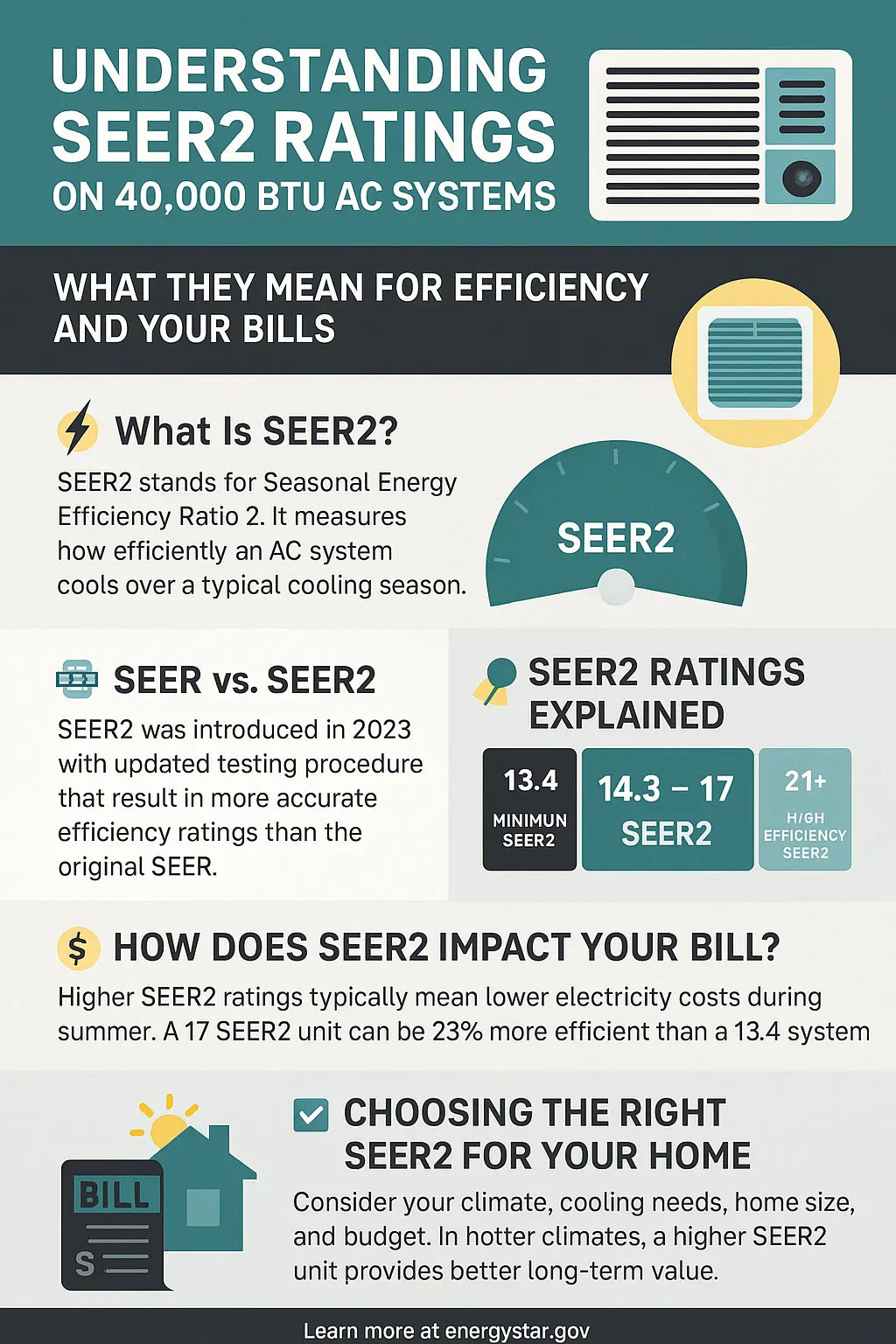A Mark Callahan Practical Guide to SEER2 Before Buying Your Next System
⚡ What Is SEER2, and How Does It Differ from SEER?
SEER (Seasonal Energy Efficiency Ratio) measures cooling efficiency over a typical season, calculated as cooling output divided by energy used.
SEER2 replaced SEER in 2023 using updated testing procedures:
-
Reflects real-world static pressure conditions more accurately.
-
SEER2 ratings are typically 0.5–1 lower than SEER for the same system under older testing.
A higher SEER2 means greater cooling efficiency, reducing electricity use while maintaining comfort.
See Energy Star’s guide on SEER2 for more details.
📈 Why SEER2 Matters for Homeowners
✅ Energy Savings: Higher SEER2 systems use less energy to cool your home. ✅ Comfort: Better humidity removal and consistent temperatures. ✅ Environmental Impact: Reduces greenhouse gas emissions. ✅ Long-Term Savings: Lowers your utility bills over the system’s lifespan.
🔍 SEER2 Ratings Explained
Typical SEER2 ratings for 40,000 BTU (about 2–2.5 ton) AC systems:
-
13.4 SEER2: Minimum efficiency for northern states.
-
14.3 SEER2: Minimum for southern states (2023 standards).
-
15–17 SEER2: High-efficiency systems.
While higher SEER2 systems cost more upfront, they save on electricity over time.
💰 How SEER2 Affects Your Energy Bills
Example for a 1,200 sq. ft. home in a moderate climate:
-
13.4 SEER2: ~$700/year in cooling costs.
-
15 SEER2: ~$620/year.
-
17 SEER2: ~$560/year.
Over 10 years, upgrading from 13.4 to 17 SEER2 can save $1,400–$1,800 on electricity, depending on rates and climate.
Use Energy Star’s Savings Calculator for your scenario.
🛠️ SEER2 vs. Climate Zone Considerations
The ROI of a higher SEER2 system depends on climate:
-
Hot climates (Zones 1–3): Higher SEER2 (15–17) pays off quickly.
-
Moderate climates (Zones 4–5): 14.3–15 SEER2 balances savings and cost.
-
Cool climates (Zones 6–7): 13.4 SEER2 may be sufficient unless high efficiency is desired for environmental reasons.
Check your DOE Climate Zone before selecting your system.
🪙 SEER2, Tax Credits, and Rebates
To qualify for 2025 federal tax credits and many utility rebates:
-
AC systems typically need at least 15 SEER2 (check regional requirements).
-
Federal tax credits: Up to $600 for qualifying AC systems (IRS Energy Credits).
-
State and utility rebates can add $100–$1,000 in additional savings (DSIRE).
Higher SEER2 systems may cost more upfront but can reduce the effective cost through rebates while lowering your bills.
🧩 SEER2 vs. Other Efficiency Metrics (EER, AFUE)
-
SEER2: Measures seasonal cooling efficiency.
-
EER (Energy Efficiency Ratio): Measures cooling efficiency at a single temperature (95°F); useful for hot climates.
-
AFUE: Measures furnace heating efficiency; separate from AC efficiency.
For full system efficiency planning, consider all metrics together.
✅ Choosing the Right SEER2 for Your Home
Checklist for Mark Callahan: ✅ Determine your climate zone.
✅ Assess your typical cooling hours per year.
✅ Balance budget vs. long-term electricity savings.
✅ Check eligibility for rebates and tax credits.
✅ Consider comfort goals (humidity control, even cooling).
For most 1,000–1,400 sq. ft. homes:
-
15 SEER2 often balances cost and efficiency.
-
17 SEER2 for maximum savings and comfort in hot climates.
🔧 Maintaining Efficiency Post-Purchase
To keep SEER2 performance high:
-
Change filters regularly (every 1–3 months).
-
Keep outdoor coils clean.
-
Schedule annual professional maintenance.
-
Ensure refrigerant levels remain correct.
-
Keep vents clear for proper airflow.
For maintenance guidance, see Carrier’s AC Maintenance Guide.
📝 Conclusion
SEER2 ratings directly impact your comfort, energy bills, and eligibility for incentives.
For Mark Callahan and homeowners planning a 40,000 BTU AC system:
-
Understand your climate and usage.
-
Compare upfront cost vs. long-term savings.
-
Check for rebates to reduce system cost.
-
Maintain your system to retain efficiency.
Choosing the right SEER2 ensures your system will keep you cool affordably for years.
Explore The Furnace Outlet’s 40,000 BTU AC Systems to find high-SEER2 models that match your goals.
In the next topic we will know more about: Is a 40,000 BTU Furnace and AC System Right for Your Home? Sizing Tips & Layout Guidance







